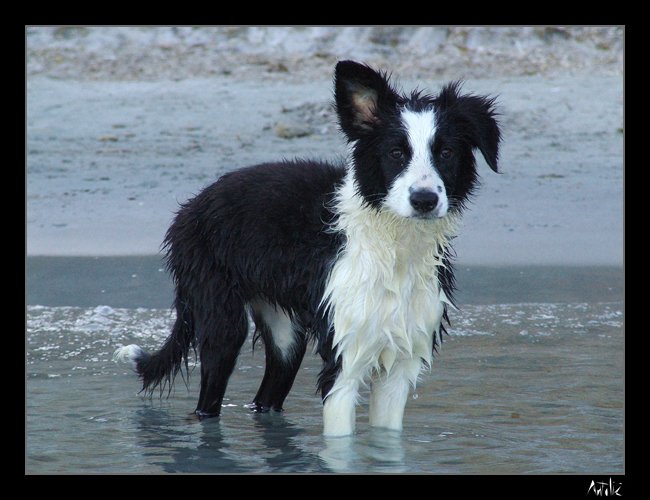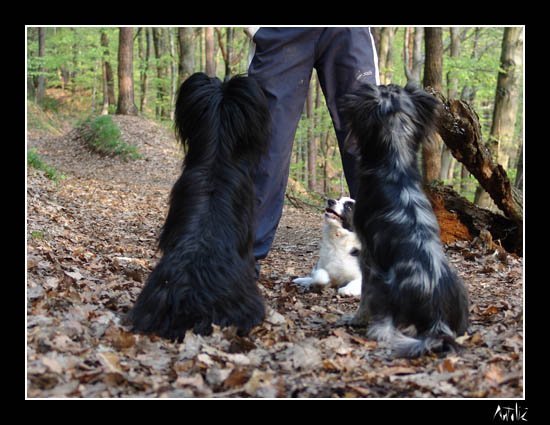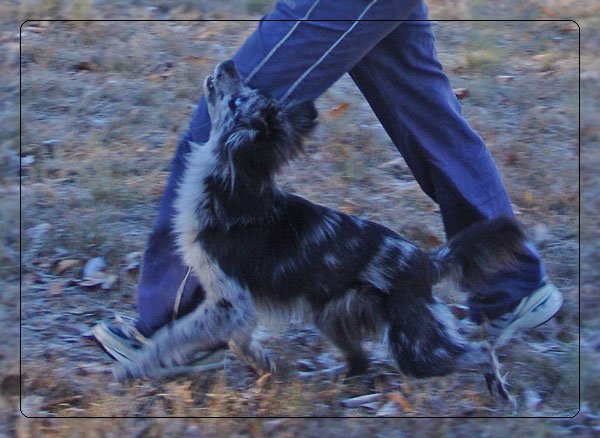FAQ on puppy & tricks training
In this FAQ, I’m answering some questions on puppy training, craziness and some other questions on some of the training techniques I explained in previous articles… So in case you want to understand all, you might need to read all other things too as this doesn’t cover everything on puppy and tricks training… Yeah, I’m really not a very systematic person… Anyway, as always, all this is only explanation of how *I* do things. I don't think it's the best way or the only way, it's just what suits best to my own chaotic personality. It’s on you to choose your way.

- The very first time you let a puppy take a jump (bar on the ground of course), how do you do that? Do you do the thing that you describe on your site for learning speed to the puppy (someone holding the puppy and owner running away and calling) and just put a jump right before the puppies nose, so that he crosses the bar as he runs to the owner or how???
We did it that way when I was still teaching straight lines first. But now, I first teach cik&cap around objects and then eventually use a jump wing as an object (with no bar at all at first). After I already run little courses with cik&cap around the jump wings, I put bars on the floor and so far, no puppy was bothered by it as they already knew the game that well. That’s their first and for quite some time, the only encounter with jumps. They learn distance, searching for obstacles on their own and pulling towards them all in the same time in this process.
- Is cik&cap then pretty much everything one needs to run a complicated A3 course ?
Pretty much. Cik&cap also include sending and therefore give you distance skills too. Also, I don't do cik&cap just around one wing, I actually put up a little course with just cik&caps pretty early in puppy's training (as soon as I can send her around an object without any help), so by the time she starts in A1, she already did many little, but difficult courses. Apart from cik&cap, go, come and maybe out/around, you really don't need anything more. – Apart from independent obstacle performance, good physical conditioning and deep relationships and understanding with your dog, of course. Oh, and some experience with handling, of course: it’s only as easy if you already know your way around a course. If you’re a beginner yourself too, it does slow down a process a little, but it most certainly helps if at least a dog is well trained and knows cik&cap very well!
- What does “out/around” mean? Is it used for discrimination? And how do you teach this out?
No, out is not used for discrimination. For discrimination, I only use obstacle name. Out/around means to take the jump from the other side and jump it towards me. It's useful to not be forced to push a dog around with your body, but can let him do it on their own when you move in the position for next sequence. As with most things (see below), I don’t train it systematically, I just use the word every time I push the dog to the other side of a jump and eventually, just start helping less and less.
- How do you teach obstacle discrimination?
I don't specifically teach it. I just use the right word for every obstacle each time, if possible even several times when a dog is running towards it and they all picked it up very quickly and never had problems when things got more difficult. In general, my dogs mostly pick up things somewhere on a way. I’m not very systematic person and never go to a training with a plan (yeah, I know I’m terrible trainer because of that!). I’m only very systematic with contacts, weaves and cik&cap. By the time the dog learns it to the level I want, she has somehow, somewhere, already learned everything else...
See, that’s why I don’t do a training video: I don’t systematically train dogs, they just pick up things as we go.:) Of course, you can train this more systematically, but it involves some drilling and I try to avoid drilling as much as possible, so I never went into systematic obstacle discrimination training.
- I know you say you spend 24 hours a day when you get a puppy, but
if you aren’t training/playing with the puppy what is it doing? Is she
free to play with your other dogs?
Sleeping! We spend so much time playing and learning and socializing that they always drop dead when we're finished. Never had a puppy make a noise at night in my life! – O.k., with an exception of a “needing to pee” warning for first two weeks – by then, they were all sleeping whole night – and my nights are looong!
I try to offer my puppies as much playing opportunities with other dogs as possible too, but they don't want to play between each other (PyrShep thing, I guess...): they will sometimes chase each other when on walks, but they never play inside and Lo and La won't play with puppies at all. I think Bu will be a little happier to amuse my next puppy, but Lo and La sure aren't impressed by puppies, they find them absolutely annoying.

- So I know you don’t think start-lines or stopped contacts are important, but do you feel that its important to train your dog to have self control?
Well, depends on "important for what and for who". It is important for
stopped contacts, start line stays, in schutzhund training, herding and
for a well behaved pet. So I guess it can be very important for some
people and for some aspects of training. For my personality and my
training, it's not important at all. I guess training by shaping is
creating some of self control as a side product itself, but I don't
specifically work on it, no. I don't think dogs need control. Dogs need
directions. I find well behaved dogs like my BC a little boring and
prefer psycho dogs like La (- and even I might get nuts with 5 La-like
dogs!). But it's just my personal preference, I don't think it's
necessary to have a dog like that to do well in the sport. It's actually
probably easier to do well if you don't have a La-like dog.
- What about for dogs that want to chase the dog in the next ring... Should they learn self control?
No, they should learn that their handler is more interesting that
anything. My dogs do go crazy when I run one of them, but they couldn't
care less about what other dogs are doing as long as I'm not involved.
- Are your dogs allowed to be crazy on the field but then at home they are behaved or are they just always crazy?
Well, depends which. Bu is always behaved, Lo is mostly behaved and La
is never behaved.:)
And I guess you can guess that La is my favouriteJ.
- What about when you’re training your other dogs, are they allowed to bark and be crazy?
Yes. They go nuts when I train with one of them and the other two are in
a car. Fortunately, tricks don't excite them as much, at least when they
can't see it, so when I work on tricks at home, I just leave the other
two in another room, at first always with something to chew on, and
fortunately, they never make a sound - what is especially important as I
live in an appartement.
- You also say you think obedience is important, but that’s outside the agility field right?
It's outside agility yes. It doesn't directly affect performance in
agility, the reason I like it is simply because it's so boring and
therefore brings more challenge to motivate a dog as agility does. So
basically, if you can do it in obedience, you shouldn't have a
motivational problem in agility.

- Don’t you think that all the heeling produces a Velcro dog?
No. If you train a dog to heel, you can still teach him to go ahead tooJ.
It’s not like you can only teach a dog one thing! I always emphasis the
importance of teaching a dog as many things as you can think of. And no,
it’s not true that teaching distance is more difficult if you
teach close work too. In fact, more things your dog knows, easier every
next thing is as he understands the concepts of learning
that much better.
- How do you teach XY trick?
I get many questions on that or another trick. I already explained some of the tricks, but as there are so many, I really can’t describe them all, so this will be more of a “in general” answer. So, in general, I shape it. I lure the easy, simple tricks like left&right, cik&cap, sit&down, figure 8, back etc. More complicated ones, I mostly shape, starting with a small, easy element of a trick and then work from there. For example, for heeling, I first click any eye contact, then moving around with me while keeping an eye contact and then I start clicking for better and better positions, heaving of front legs, lowering hind end etc. I also shape 2on2off, in a box, on a box, circling an object with rear feet when front feet are on an object, putting one bowl into another, throwing a blanket over the head, crossing of the legs, skateboarding etc.
Very often, I also build tricks together: figure 8 backwards is made from “front” position, “heel” position on both sides and “back” command. Flips from my body are a combination of “in my lap” trick and a toy lure away from my body. “Diagonal” and “left/right” legs up is build from “leg x” + “leg y” and “leg x” was taught by shaping (clicking shifting weight, taking weight off one leg, moving that leg, lifting that leg and then prolonging the time the leg is up). You can also teach it as 2on2off, just that left/right legs are on/off.
I don’t use targeting all that much, but some of the tricks are taught with targeting too, like walking with front feet on my feet, digging, walking in slippers, sitting up etc. I also trained La’s headstand with rear foot targeting (and Bu’s with 2on2off). Head down, “where is your hip”, “where is your paw” and “yes” and “no” were trained with nose targeting.
I also use capturing for tricks like licking of the lips, head shake, a stretch etc.
See: it’s easy. I’m often asked to do a "how to" dvd on teaching tricks, but hey, you really don’t need that, it’s really not all that difficult, the key with all the tricks is to search and reward for anything that goes in the right direction and then slowly ask for more and more. I agree it’s sometimes difficult to get an idea for a trick, that’s why I put mine on videos to give you some ideas, but the process of training a new trick is really not all that hard to figure it out. There are many different ways to train that or another trick and figuring out what would work best for you and your dog and trying it out is important part of a process, time much better spent as watching dvds... Remember, the goal of teaching tricks is not to teach as many tricks in as little time as possible, but to get to know your dog better, get to understand how s/he thinks and how s/he learns and to find the best ways to communicate with him/her. And first and foremost: to enjoy that process!!! You can't learn that from any dvd or a book, you need to try and see it yourself.
- Do you only teach one trick at the time?
No, I almost always teach more at the same time, very often even within the same session, I just make sure we change a place or an object we’re using if we’re using one. And yes, of course it can create some confusion, but it’s really not the end of the world, we only do tricks to keep the dogs happy and busy.
- How long are your tricks training sessions?
Not very long with a puppy as I run out of her meal very fast. With adults, I can work as long as I want, they will never stop working. We went on for as long as 3 hours at the time when we were putting together that tricks show with a friend and her Mudi. - But mostly, when I’m teaching something new, I run out of food in like 15 minutes.

- How long are your agility training sessions?
With adults, I normally train three times a week and run 3 to 4 courses with each, re-doing the parts that could be better if there were some. I change the dogs after every course, meaning that each dog is doing agility 3 to 4 times per less than 1 minute on an average (about 30s for a course + some additional seconds for redoing things when necessary), with breaks in between each session. I guess that means my dogs do 3 minutes of agility per training, 2 to 3 times a week Together with changing height of the bars, thinking of a new course, playing, warming up etc. it takes me an hour to one hour and a half to be finished with all three of them. When I have a new puppy, it all takes somewhat longer as there is even more playing involved.
- Is that true? Only 3 minutes of agility three times a week to create a world team dog??
Well, yes, 3 minutes, 3 times a week of work on equipment… But many, many hours of creating a firm, trusting relationships, teaching hundreds of tricks, walking in the woods, playing and creating the right crazy, confident attitude. I thought that’s what agility is all about? Obstacles are easy, you really don’t need to spend too much time on them, you should keep them as something very special for the dog. The challenging part is the path between the obstacles - and you can work on that without any real obstacles.